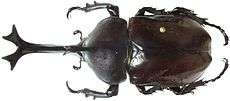Japanese rhinoceros beetle
| Japanese rhinoceros beetle | |
|---|---|
 | |
| Scientific classification | |
| Kingdom: | Animalia |
| Phylum: | Arthropoda |
| Class: | Insecta |
| Order: | Coleoptera |
| Family: | Scarabaeidae |
| Subfamily: | Dynastinae |
| Genus: | Allomyrina Arrow, 1911 |
| Species: | A. dichotoma |
| Binomial name | |
| Allomyrina dichotoma (Linnaeus, 1771) [1] | |
| Synonyms | |
| |
The Japanese rhinoceros beetle, Japanese horned beetle, or kabutomushi (カブトムシ), Allomyrina dichotoma, is a species of rhinoceros beetle.
Etymology
In Japanese, rhinoceros beetles are called kabutomushi (かぶとむし, also written 甲虫 or かぶと虫). Mushi is Japanese for bug, and kabuto is Japanese for helmet. So, literally, it means helmet-bug referring to a samurai helmet.[2]
List of subspecies
- Allomyrina dichotoma dichotoma
- Allomyrina dichotoma inchachina
- Allomyrina dichotoma septentrionalis
- Allomyrina dichotoma takarai
- Allomyrina dichotoma tunobosonis
Description

Allomyrina dichotoma shows a striking sexual dimorphism. The males are much larger, reaching a length of 40–80 mm, while females can reach a length of about 40–60 mm. The long cephalic horn of this species has a characteristic shape in the form of the letter Y and it is used by males during the mating period and to maintain territories.[2] By means of their forked horn they lift other males off the ground and throw them into the air.[2] In addition to their impressive and ornate protuberance they also have a smaller thoracic horn, also forked. Their eyes may be white or red and are adapted to low light levels, as this species is nocturnal.[2] The body is dark brown, while the ventral part of the body is black, brilliant and the front legs are unusually long. Like all Dynastinae species, these beetles are strong flyers,[2] although they never cover long distances during the flight. The preferred foods are tree saps, fruits and anything sugary.[2]
Distribution and habitat
This species is present in Japan (Honshu and Kyūshū), Taiwan, Korea and eastern China.[4] It can be found in broad-leaved forests in tropical and subtropical mountainous habitats.
Lifespan
The Japanese rhinoceros beetle will live most of its life underground,[2] for it only lives about four months as an actual beetle. The earliest beetles will come out of the ground in late spring; they will usually die around middle September to early October. They usually will die after mating and laying eggs.
The eggs are laid directly in the ground, then hatch into a wriggling larva, which usually mature in a year.[2] But life as an adult is short; in less than 4 months he must find and defend a territory and mate. Combat occurs between males competing for mates. Male beetles normally die in the fall after mating many times, whereas female beetles normally die after laying eggs.
Japanese kabuto breeders are trying to find supplements to make the Japanese rhinoceros beetle mature faster and grow to a larger size.
Popular culture

Japanese rhinoceros beetles are very popular in anime, tokusatsu, advertisements, televisions, and films in Japan.
Many children in Japan buy or catch these beetles and breed them. Male and female insects will cost about 500 to 1000 yen (approximately five to ten US dollars). This beetle is sold as a pet in department stores[2] in many countries of Asia where it is also frequently depicted in popular media as a common cartoon character for various uses, for example much as gorillas, lions, or T. rex are seen in advertisements and product labels in the United States.
Japanese rhinoceros beetles are a very popular subject in gambling, like Siamese fighting fish and cricket fights. In the most popular game, two different male beetles are placed on a log.[2] They will battle each other, trying to push each other off the log, the one to stay on the log is the winner. This is a huge source and loss of money to many people, especially in the Ryukyu Islands.
Bibliography
- Y. Hongo Does flight ability differ among male morphs of the Japanese horned beetle Trypoxylus dichotomus septentrionalis (Coleoptera Scarabaeidae)? Ethology Ecology & Evolution - Volume 22, Issue 3, 2010
- Yoshihito Hongo Behaviour During Male-male Interaction in the Japanese Horned Beetle Trypoxylus Dichotomus Septentrionalis (Kono) Behaviour, Volume 140, Issue 4
- YUTAKA IGUCHI Intrasexual fighting and mounting by females of the horned beetle Eur. J. Entomol. 107: 61–64, 2010
- Van Truong T, Byun D, Lavine LC, Emlen DJ, Park HC, Kim MJ. Flight behavior of the rhinoceros beetle Trypoxylus dichotomus during electrical nerve stimulation.
References
External links
| Wikispecies has information related to: Japanese rhinoceros beetle |
| Wikimedia Commons has media related to Allomyrina dichotoma. |
- Photos of Allomyrina dichotoma septentrionalis
- Photos of Allomyrina dichotoma tunobosonis
- Photos of Allomyrina dichotoma
- Watts, Jonathan (11 August 1999). "Vending machine beetles". The Guardian. London. Retrieved 13 May 2011.